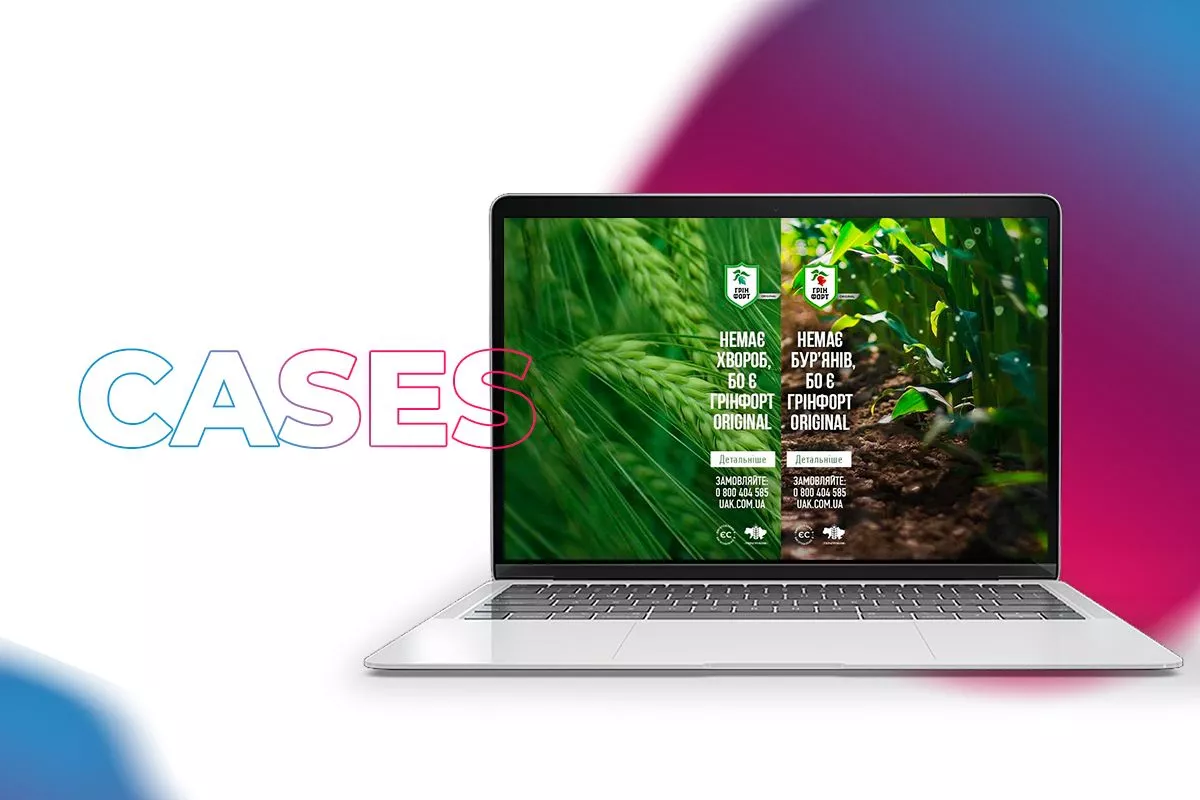While the coronavirus crisis has barely affected the plant protection product market, some companies have experienced delivery delays. Products were imported from China, and the country was quarantined for a long time. The 2020 plant protection product sales season started earlier, so the peak was in March-June.
This time we cooperated with Ukragrocom, a well-known player in the agricultural market of Ukraine. For the first time, the company conducted a comprehensive digital placement, in which the advertising campaign reached 4 million users and brought 40,000 people to the site. We tell how we managed to reach a special target audience.
The goal is to stimulate offline sales
Ukragrocom has planned to launch an updated product. The brand has not changed, but there is a need to tell farmers about different types of products for each crop. We had to stimulate sales, which mainly occur offline — with the help of managers. The advertising campaign lasted from March to June 2020. The products were already well known in these regions: Kyiv, Kharkiv, Odessa, Lviv, Lutsk, Poltava, Vinnytsia, Zhytomyr, Sumy.
What do farmers do online?
The core of the target audience is men aged 30-60, agronomists, managers and owners of enterprises that grow crops. “Audience research is pretty ad hoc. The market is competitive, everyone is trying to inherit the leaders. But with a change in brand positioning, or in sales channels, research is mandatory. The needs of our target audience are mainly the following: expanding the range of products and services; innovative (as a rule, this also means eco-trend) products and approach; transparency and adherence to the terms of partnership — this is what the company focuses on,” — says Yevheniia Plichko, Marketing Director of Ukragrocom.
“The audience is specific — it is difficult to separate professional intentions while using the Internet. We are all people, someone comes to watch a movie, and not to look for information about fertilizers. And in general, the agricultural industry is slowly digitizing, there is not much thematic content on the sites,” — says Andriy Batmanov, Head of Digital Planning MixDigital
How to conduct effective communications in a short time: tools and approaches
Agro-industry is a large sector of the state economy, but the consumer audience here is specific. Therefore, at the level of tactical decisions, we had to select tools with flexible targeting settings, and use direct placements on specialized sites.
The seasonality of buying fertilizers is quite narrow: the end of February — the beginning of June.
“Before the 2019-2020 season, we did not launch complex digital campaigns, there was only Facebook with content promotion. This need arose with the renewal of visuals and brand positioning. We were confused about the cost of conversion analysis in the tool. If digital tools are just beginning to be used, a clear argument for their use is needed,” says Yevheniia Plichko,
But the end consumer (especially distributors in the agricultural market), despite the characteristics of the sector and the path of the buyer, is increasingly paying attention to digital promotion channels. Therefore, we are slowly moving away, for example, from printed publications.”
We worked both at the upper levels of involvement — to build reach, and at the bottom — to involve in the purchase of products process.
To build awareness, we used video advertising — this is the most effective tool for this purpose. We used targeting by interests, intentions, interested buyers, life events, formed special intent audiences (URLs, keywords). For placement, we used the most popular in-stream video platform — YouTube, with a format that is aimed at building the maximum reach for Reach.
For banner advertising, we also used placements in the GDN network, which made it possible to complete the frequency of contact and reduce its cost. Narrow targeting was set up. The approach is similar to YouTube placement. Audiences were divided by interests, such as “home and garden”, selected special audiences by intent, for example: “plant protection from pests”, identified audiences of interested users: “industrial products”, chose audiences by life events: “starting your own business”, special audiences by URL: “agriculture” and others.
Advertising was also placed on specialized sources: latifundist.com, Kurkul.com, superagronom.com. The websites’ traffic is relatively low, but the audience is the most targeted. Therefore, here we placed static and dynamic banners.
Thanks to flexible targeting settings and the ability to target by job level, it made sense to use Facebook with promotion in the news feed.
Google tools were used for generated demand. Placed paid ads on the search queries page for branded, commercial, general, and competitor queries. We also used banner advertising with purchasing by CPC and settings for relevant interests in Gmail.
In addition to digital advertising, the client placed ads in the agricultural press (Agrobusiness Today and Farmer magazines), outdoor advertising, and round tables were held, which reached relatively few people.
“For such narrow categories, you can use the entire arsenal of targeting options in systems, such as Google, explains Andriy Batmanov, — these can be both broader targeting by interests, and narrow ones — by content, special audiences, keywords, audience by intent. Of course, in the context of agricultural clients, targeting is related to this topic.”
Conclusions — cooperation with farmers should be continued
We have reached more than 4 million target users, and received more than 40 thousand clicks on the landing page. Based on results from Google Analytics, we determined that theme sites and Gmail Sponsored Promotions had the lowest bounce rate and highest session duration. This says that they are the most effective in attracting interested users.
This was the first comprehensive digital communication of Ukragrocom, the results, according to the client, added visibility to the brand in the digital field. “One flight of the campaign, which is carried out for the first time, given the characteristics of the industry (lack of online sales), cannot immediately and significantly increase sales. We need to aim for consistent work with digital in order to achieve a commercial effect,” — Yevheniia Plichko sums up.








